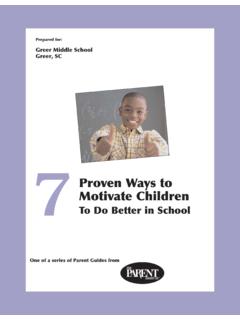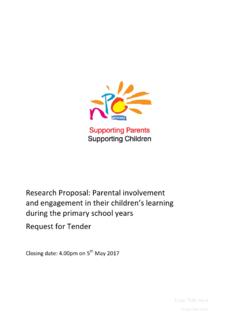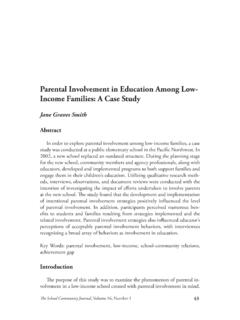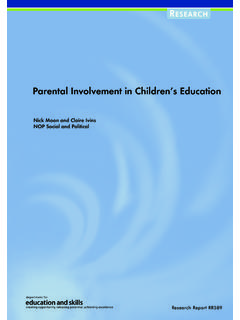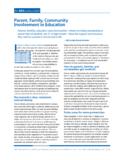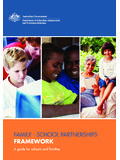Transcription of Epstein's Six Types of Parent Involvement What Can You …
1 Epstein's Six Types of Parent Involvement What Can You Do To Get Involved Educational Tools for parents and Children Research National Network of Partnership Schools - The National Network of Partnership Schools guides school, district, and state leaders, and teams of educators, parents , and others to improve school, family, and community partnerships. Studies are being conducted on the structures and processes used to "scale up" programs of partnership to all schools in a district or state, and the results of these programs. Center on School, Family, and Community Partnerships - The mission of this Center is to conduct and disseminate research, development, and policy analyses that produce new and useful knowledge and practices that help families, educators, and members of communities work together to improve schools, strengthen families, and enhance student learning and development.
2 For a listing of documents available from the Center on School, Family, and Community Partnerships, please see our Publications Lists. The Center for Research on the Education of Students Placed at Risk (CRESPAR) at Johns Hopkins University - The Center for Research on the Education of Students Placed at Risk (CRESPAR) at Johns Hopkins University. Studies focus on the effects of school, family, and community partnerships, and on the development of preservice, inservice, and advanced courses in partnerships for teachers and administrators Publications School, Family, and Community Partnerships: Your Handbook For Action by Joyce L.
3 Epstein., et. al. This "user-friendly" handbook enables state, district, and school leaders to organize and implement positive and permanent programs of school, family, and community partnerships. A New Wave of Evidence, The Impact of School Family and Community of Student Achievement Annual Synthesis 2002. by: Karen Mapp and Ann Henderson Epstein's Six Types of Parent Involvement Joyce Epstein of Johns Hopkins University has developed a framework for defining six different Types of Parent Involvement . This framework assists educators in developing school and family partnership programs.
4 "There are many reasons for developing school, family, and community partnerships," she writes. "The main reason to create such partnerships is to help all youngsters succeed in school and in later life.". Epstein's framework defines the six Types of Involvement and lists sample practices or activities to describe the Involvement more fully. Her work also describes the challenges inherent in fostering each type of Parent Involvement as well as the expected results of implementing them for students, parents , and teachers. The following information is excerpted from Epstein's work.
5 Epstein's Framework of Six Types of Involvement and Sample Practices 1. PARENTING: Help all families establish home environments to support children as students o Parent education and other courses or training for parents ( , GED, college credit, family literacy). o Family support programs to assist families with health, nutrition, and other services. o Home visits at transition points to pre-school, elementary, middle, and high school. 2. COMMUNICATING: Design effective forms of school-to-home and home-to-school communications about school programs and children's progress.
6 O Conferences with every Parent at least once a year. o Language translators to assist families as needed. o Regular schedule of useful notices, memos, phone calls, newsletters, and other communications. 3. VOLUNTEERING: Recruit and organize Parent help and support. o School and classroom volunteer program to help teachers, administrators, students, and other parents . o Parent room or family center for volunteer work, meetings, resources for families. o Annual postcard survey to identify all available talents, times, and locations of volunteers.
7 4. LEARNING AT HOME: Provide information and ideas to families about how to help students at home with homework and other curriculum-related activities, decisions, and planning. o Information for families on skills required for students in all subjects at each grade. o Information on homework policies and how to monitor and discuss schoolwork at home. o Family participation in setting student goals each year and in planning for college or work. 5. DECISION MAKING: Include parents in school decisions, developing Parent leaders and representatives.
8 O Active PTA/PTO or other Parent organizations, advisory councils, or committees for Parent leadership and participation. o Independent advocacy groups to lobby and work for school reform and improvements. o Networks to link all families with Parent representatives. 6. COLLABORATING WITH COMMUNITY: Identify and integrate resources and services from the community to strengthen school programs, family practices, and student learning and development. o Information for students and families on community health, cultural, recreational, social support, and other programs or services.
9 O Information on community activities that link to learning skills and talents, including summer programs for students. o Service to the community by students, families, and schools ( recycling, art, music, drama, and other activities for seniors or others). What Can You Do To Get Involved How Can I Be Involved In My Child's Education? Research studies consistently reveal that high student achievement and self-esteem are closely related to positive parental participation in education. parents and schools need to work together so all children can succeed in school.
10 Almost everyone agrees that parents are, after all, their children's first and most important teachers. You, as a Parent , have important knowledge about your child's likes, dislikes, needs, and problems that the school may not be aware of. You may also have ideas for improving your child's school. But even though studies show that most parents want to be involved in their children's education, they may not be exactly sure how to go about it, especially if, like most parents , they work during the school day. parents often ask the following questions: What Can I Do To Involve Myself With My Child's School?
